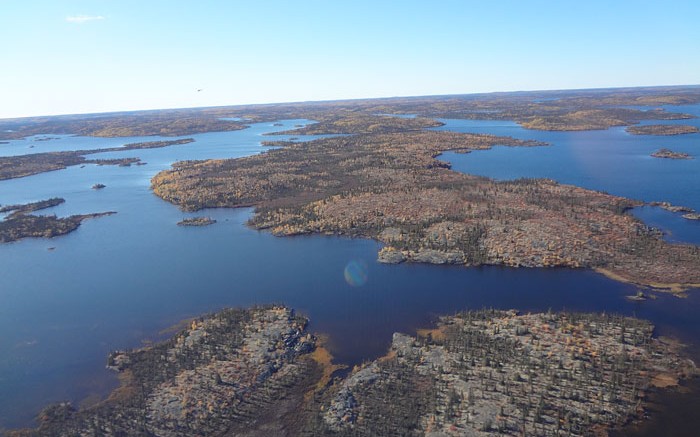When David Wiley took the helm at Merc International Minerals in August 2010, the company had one small property in the Indin Lake greenstone belt in the Northwest Territories, 200 km north of Yellowknife.
So Wiley and chief geologist Michael Byron set out to increase the junior explorer’s assets by staking and acquisitions, and today, the company — now called Nighthawk Gold (TSXV: NHK; US-OTC: MIMZF) — controls over 90% of the prospective Indin Lake greenstone belt, an area it describes as one of Canada’s most underexplored gold camps. The belt lies within the West Bay–Indin Lake fault zone, which extends more than 200 km from the Giant and Con gold mines in the south to the Colomac gold mine to the north. Their property contains 14 known gold deposits and showings, three of which are historic mines.
Wiley and Byron’s first big break came at the end 2011, when the company signed an agreement to acquire the past-producing Colomac open-pit gold mine, 220 km northwest of Yellowknife. During the 1990s the mine produced 527,908 oz. gold at an average head grade of 1.66 grams gold per tonne under two previous owners: Neptune Resources and Royal Oak Mines.
The Colomac acquisition came with four satellite deposits — Grizzly Bear, Goldcrest, Dyke Land and 24/27 — and increased the junior’s total land position in the Indin Lake greenstone belt to 980 sq. km.
Colomac had been mined down to a vertical depth of less than 200 metres. But Royal Oak shut it down in December 1997, citing low gold prices, and filed for court protection from its creditors in April 1999.
Wiley and his team picked up the property from Aboriginal Affairs and Northern Development Canada in exchange for committing $5 million to reclaim three disturbed historic exploration sites near the mine.
It was a milestone for the company. “There had been so much work done there that we ended up with a whole database of holes,” Wiley says. “The historic data has been such a great pathfinder for us because someone else did so much of the work.”
A year after closing the acquisition and resampling the data and doing its own drilling, the company reported its first National Instrument 43-101 inferred resource in February 2012 of 42.7 million tonnes grading 1.05 grams gold per tonne for 1.45 million oz. gold, at a cut-off grade of 0.6 gram gold per tonne.
In June 2013, Nighthawk updated the Colomac inferred resource to 39.8 million tonnes grading 1.67 grams gold for 2.1 million oz. gold.
Late last year, Nighthawk added the Kim and Cass gold deposits 15 km and 20 km southwest of Colomac, which Wiley describes as “the missing pieces of the puzzle.” Kim and Cass are connected by road to the Colomac mine and according to Wiley, Royal Oak had plans to develop Cass as a satellite deposit for the Colomac mill, but the company closed Colomac before production at the Cass zone.
Cass has had more than 13,500 metres of historic drilling, and Kim more than 18,000 metres.
Historic resource estimates that predate the implementation of National Instrument 43-101 regulations were calculated for each of the deposits, Wiley says, the most recent of which was compiled by Royal Oak Mines in 1995.
Wiley says that since the year started “we’ve been going through the bankers boxes, converting everything, digitizing everything, to see what we’ve got — and we’ve got a large amount of valuable historic data,” Wiley says. “All of the core is on-site so it’s been fairly straightforward, but time-consuming.”
Wiley says that from all 15 bankers boxes of material management has found three vintages of drill information dating from 1986, 1987 and 1995.
“They had great intercepts and the majority were within 75 metres of surface, and all of the core is on-site,” Wiley says. “The reason Royal Oak built the road was because it was higher grade and a shallow area that Royal Oak was looking to develop.”
On March 26, Nighthawk reported assay results from 18 historic holes drilled in 1986 from the Cass deposit, with highlights including 5.67 grams gold across 36.9 metres, 6.53 grams gold over 26.7 metres and 3.35 grams gold over 41.4 metres.
“We’ve been fortunate in being able to acquire ounces very cheaply,” Wiley says. “We’ve got the best geological team in the business as far as I’m concerned, and we’ve been able to do incredible merger and acquisition deals that have resulted in a bona fide gold camp. Between the work we’ve done on M&A and what our geologists have been able to do, it’s an incredible story. We’ve been able to go into this Indin Lake gold camp because it’s been underexplored and take advantage of all the historic data and pull it together. We believe it’s Canada’s next big bona fide gold camp. And we have a supportive investor base.”
As of December 2013, Dundee Corp. held a 17.7% stake in the company, and Northfield Capital Corp. a little under 17%, according to company filings on Sedar.
Wiley also notes that the company has a healthy cash balance.
“At the end of the day, our cash burn is low enough that we’re riding it out through this unfortunate time in the mining business by doing all we can with historic data and making as many inroads as we can on the permitting front and government–native relations, and understanding the old data so we can grow what we’ve got without spending money on drilling.”
“As the market comes back, we’ll be able to be a lot more active, but we have great financing sources that are there and are committed to backing us. The market just hasn’t realized the value of what we’ve got.”


Be the first to comment on "Nighthawk has golden plans for Indin Lake"